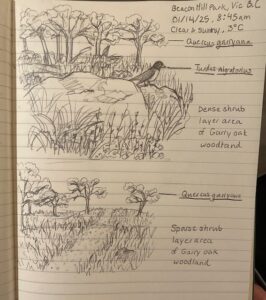This visit to Beacon Hill Park in Victoria, B.C. was on January 14th, 2025 at around 8:45am. The conditions were clear and sunny, with a temperature of 3 degrees Celsius and negligible wind.
I have decided to make the American Robin, Turdus migratorius, my organism of interest to study. Given that this park is regularly maintained to protect against overgrowth of invasive plant species, I realized that studying the patterns of an invasive plant such as Scotch broom like I had mentioned earlier here wouldn’t be feasible as it produces external confounding variables that I cannot control for.
I am observing American Robins along a gradient of Garry Oak woodlands in Beacon Hill Park. There are distinct regions within the woodlands that can be differentiated by the relative density of understory (specifically, shrub density). Having noticed this, I decided to observe American Robins in 3 locations across the Garry Oak woodland area: one area with sparse shrub cover, one with moderate shrub cover, and one with dense shrub cover. I identified them visually and by ear (based on their call), which has led me to more frequently notice robins in the areas of Garry Oak woodland with a dense shrub layer while fewer robins seem to be in areas with a sparse shrub layer.
Hypothesis: The frequency of American Robins within Garry Oak woodland areas of Beacon Hill Park is influenced by the density of the shrub layer.
I predict that sites with a dense shrub layer will have a higher frequency of American Robins due to more foraging and nesting opportunities.
Response Variable: Observed frequency of American Robins (number of individual birds recorded per site). This is a continuous variable.
Explanatory Variable: Shrub layer density (sparse, moderate, dense). This is a categorical variable.
